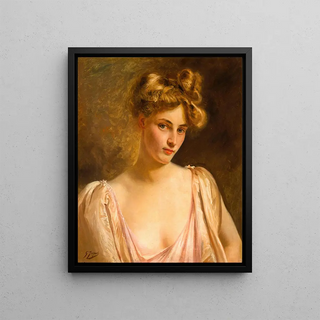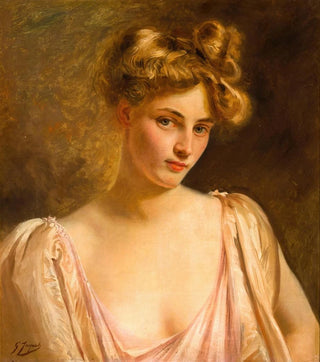Art print | A blonde beauty - Gustave Jean Jacquet


View from behind

Frame (optional)
In the vast panorama of art history, some artworks manage to transcend their era and capture the very essence of beauty. "A Blonde Beauty" by Gustave Jean Jacquet is undoubtedly one of these creations that fascinate and move. This painting, evoking infinite delicacy and grace, transports us to a universe where the sublime and the everyday meet. The model's gaze, both gentle and penetrating, seems to invite the viewer to an intimate contemplation. Through this work, Jacquet does not merely depict a female figure; he immortalizes an emotion, an atmosphere, a period.
Style and uniqueness of the artwork
The piece stands out for its academic style, characteristic of the late 19th century, but also for a personal touch that gives it an undeniable singularity. Mastery of light and shadow, along with the chosen color palette, creates a warm and welcoming ambiance. The golden nuances of the blonde hair of the model catch the light in an almost magical way, highlighting the delicate details of her face. Jacquet excels in rendering textures, whether the softness of the skin or the fluidity of the surrounding fabrics. Each brushstroke demonstrates exceptional craftsmanship, allowing the viewer to engage in a visual dialogue with the artwork. The harmony of lines and the carefully orchestrated composition enhance the sense of serenity emanating from this scene.
The artist and his influence
Gustave Jean Jacquet, born in 1846, was a French painter whose work lies at the crossroads between realism and romanticism. His career was marked by a desire to capture female beauty in all its forms, earning him increasing recognition in the artistic circles of his time. Influenced by the great masters of the past, Jacquet managed to infuse modernity into his works while respecting academic traditions. His ability to depict women with such sensitivity and refinement contributes to his status as an emblematic artist of the Belle Époque. Through "A Blonde Beauty," he does not merely

Matte finish

View from behind

Frame (optional)
In the vast panorama of art history, some artworks manage to transcend their era and capture the very essence of beauty. "A Blonde Beauty" by Gustave Jean Jacquet is undoubtedly one of these creations that fascinate and move. This painting, evoking infinite delicacy and grace, transports us to a universe where the sublime and the everyday meet. The model's gaze, both gentle and penetrating, seems to invite the viewer to an intimate contemplation. Through this work, Jacquet does not merely depict a female figure; he immortalizes an emotion, an atmosphere, a period.
Style and uniqueness of the artwork
The piece stands out for its academic style, characteristic of the late 19th century, but also for a personal touch that gives it an undeniable singularity. Mastery of light and shadow, along with the chosen color palette, creates a warm and welcoming ambiance. The golden nuances of the blonde hair of the model catch the light in an almost magical way, highlighting the delicate details of her face. Jacquet excels in rendering textures, whether the softness of the skin or the fluidity of the surrounding fabrics. Each brushstroke demonstrates exceptional craftsmanship, allowing the viewer to engage in a visual dialogue with the artwork. The harmony of lines and the carefully orchestrated composition enhance the sense of serenity emanating from this scene.
The artist and his influence
Gustave Jean Jacquet, born in 1846, was a French painter whose work lies at the crossroads between realism and romanticism. His career was marked by a desire to capture female beauty in all its forms, earning him increasing recognition in the artistic circles of his time. Influenced by the great masters of the past, Jacquet managed to infuse modernity into his works while respecting academic traditions. His ability to depict women with such sensitivity and refinement contributes to his status as an emblematic artist of the Belle Époque. Through "A Blonde Beauty," he does not merely






